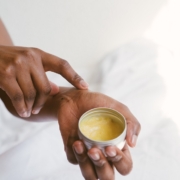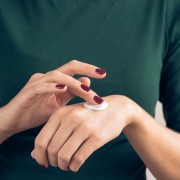
“My MI/MCI story by Amanda B.
In April of 2013, I began struggling with sleep. Friends suggested I go on Hormone Replacement Therapy, and my doctor, who knew nothing about hormones, suggested I visit a gynecologist for HRT. She also offered me sleeping pills. Not wanting either alternative, I chose to hope for the best and tough it out. But months and months later, I still wasn’t sleeping, and my thoughts and feelings began to become affected. The day before Thanksgiving, my only surviving family member and sibling was admitted into the hospital 2,000 miles away. She passed away on December 11 and I was unable to attend her funeral. My college-aged children were home and I pressured myself into preparing elaborate holiday feasts. My business, which is in full swing during the holidays, was demanding my attention. I say all of this so you can understand that I was on overload, to say the least. I fully believe that my sensitization to MI/MCI was due in large part to stress, the fact that I wasn’t handling my stress well, and my use of denial (“it will all get better”).
That Christmastime, I began experiencing itchy rashes on the back of my hands. I was at a loss as to what was causing it. I booked a January appointment with a dermatologist and they kind of shrugged, gave me a preliminary diagnosis of dyshidrotic eczema (although the presentation of my rashes was irregular for that diagnosis), gave me some very strong ointment, and sent me on my way. I read the package insert of the medication and was alarmed at how they stated it could interfere with the adrenals. I used it sparingly, and it worked.
I kept having these sorts of breakouts on my hands, but then later in 2014, I began breaking out on my face, chest and arms. These blisters were horrible. As the rash on my face was in a butterfly shape, the dermatologist tested me for Lupus, which was negative. No indication on their part as to what could be causing the rashes. More corticosteroids.
Finally in early 2015, after a facial caused my lips to flare, I insisted we get to the bottom of the problem. The dermatologist suggested a patch test to determine if I had contact allergies. She administered the TRUE test and I reacted quite strongly, and only to isothiazolinone. Not one person in the office could pronounce it, and not one person talked with me about Allergic Contact Dermatitis (ACD). They handed me a printout from the TRUE test and said, “this is what the problem is.” I immediately talked with the aesthetician who had given me the facial. She began looking on her phone right away. The first site she went to was Wikipedia, and then she went to Facebook. She found the MI group and I immediately began following. To date, these MI support groups have provided me with nearly 100% of my education on ACD.
Like everyone else with ACD, the allergy ruled my life at first (and it still does, for the most part, but I have a safe home now, and I know how to live with the diagnosis). I spent a great deal of time focusing on how to keep out of a flare. I am a jewelry artist and am exposed to chemicals on a regular basis, but it was cleaning out my basement this past winter that caused a huge flare that I couldn’t seem to heal. Although I have prescriptions for various corticosteroids, I try to use them sparingly, even to wean myself off of them, because they are known for thinning the skin, and the ingredients are absorbed into the bloodstream. So during this particular flare, I began using natural salves that were absolutely lovely (in my opinion). But something wasn’t right. I would use corticosteroids one night, the natural salves another night, and I kept flaring. There was no MI/MCI in any of the products I was using. So back to the dermatologist. She had mentioned that there was a specialist about an hour and a half away who could patch test me on a larger scale if I needed it, so I said, “it’s time”. Fortunately, I have medical insurance that would pay for it.
In April of 2016, I had my appointment and was given 129 patches on my back. The results were that I had developed sensitivities to some of the ingredients in the natural salves I had been using. My new allergens include Fragrance II, Propolis, the botanicals neroli and lemongrass, as well as ethylhexylglycerin and dodecyl gallate. I was told to avoid all fragrances, all botanical oils and beeswax, in addition to MI/MCI.
Now I use very little on my skin, as I fear that I will become sensitized to more allergens. Something that I feel has been missing in all of this is patient education about how to heal a flare once you get one. And that education for the medical community in this arena is sorely lacking. I know that doctors become highly specialized and it may be impossible for them all to know about ACD, but it seems to me that dermatologists ought to be able to patch test a patient sooner than later. I think that most of us ACD sufferers are out there floundering with no idea of diagnosis and treatment. I am grateful that Dermatitis Academy exists now to help us all through this maze!”
My Allergic Contact Dermatitis (ACD) Story is a portion of the Dermatitis Academy Blog that highlights real life, user submitted, allergic contact dermatitis journeys in an attempt to provide awareness and encouragement regarding this crippling disease.
Infographic by Peter Gust

 Photo by Retha Ferguson from Pexels
Photo by Retha Ferguson from Pexels

